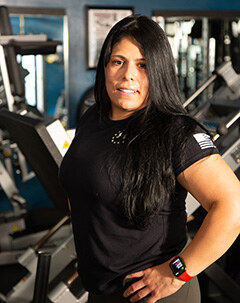Top Questions about fitness and women
Being physically active is one of the most important steps you can take to get and stay healthy. Women of all ages, shapes, and abilities benefit from getting active. Regular physical activity (exercise) can help lower your risk for many diseases that affect women, including heart disease and stroke. Exercise can also help relieve symptoms of some conditions, such as depression, type 2 diabetes, and high blood pressure. Women need to do different types of physical activities to reach or stay at a healthy weight and build strength and endurance. Read on to learn more about fitness and women.
Q: How can physical activity help my health?
A: Getting regular physical activity is one of the best things you can do for your health. Regular physical activity can help:
• Lower blood pressure and cholesterol
• Improve depression
• Improve sleep
• Lower your risk of diseases such as breast cancer, colon cancer, type 2 diabetes, heart disease, and stroke
• Lower your risk of dying early
Q: How much physical activity should I do?
A: Each week, women should get at least:
• 2 hours and 30 minutes (150 minutes) of moderate-intensity aerobic physical activity. You know you are doing a moderate-intensity activity when your heart is beating faster but you can still carry on a conversation. Try a brisk, 30-minute walk five times a week.
OR
• 1 hour and 15 minutes (75 minutes) of vigorousintensity aerobic activity. You know you are doing a vigorous-intensity physical activity when you are breathing hard and it is difficult to have a conversation. This could be a 40-minute jog or step class twice a week.
AND
• Muscle-strengthening activities on two or more days.
Q: Can I exercise if I have underweight, overweight, or obesity?
A: Maybe. People who are underweight due to an eating disorder should not exercise unless their doctor tells them to. Women who have overweight or obesity should talk to their doctor or nurse about any concerns they have about beginning an exercise program.
For most people, any amount or type of physical activity will help your overall health. Physical activity can also improve muscle strength, balance, and flexibility.
Start slowly if you haven’t been physically active before or if it has been a while. Talk to your doctor or nurse about exercise if you have a health condition. Your doctor or nurse can help you develop an exercise plan that is healthy and safe for a person of your current weight and fitness level.
Q: Can exercise help menstrual cramps?
A: Maybe. Researchers have found that some women have fewer painful cramps during menstruation if they exercise regularly. There are almost no risks to regular physical activity, like walking, which may also help you feel better during your period.
Q: Is it safe to exercise during pregnancy?
A: Physical activity during pregnancy is usually safe and healthy for you and your baby. And the more active you are during pregnancy, the easier it will be to start getting active after your baby is born. Talk to your doctor about your activity level throughout your pregnancy.
Q: How can I avoid weight gain after menopause?
A: As you age, and especially in the years after menopause, you may find it harder to maintain your weight. You may need to increase the amount of physical activity you get and lower how many calories you eat to stay the same weight.
Q: How can physical activity help older women?
A: As you get older, regular physical activity helps:
• Keep bones strong
• Prevent hip fractures (breaking your hip)
• Decrease pain from arthritis
• Prevent dementia
• Maintain your independence
Balance exercises are important for all women, but especially older women who are at a higher risk of falls. Examples of these exercises include tai chi and standing from a sitting position.
If you would like to learn more about fitness and women, contact us for a consultation to see how we can help you.
Why is Building Muscle Beneficial?
Building muscle can do more for your body than just increasing strength. Yes, there’s a high that comes with hitting your squat max, but the benefit runs so much deeper than those feelings of accomplishment.
Muscle Building Offers Joint Support
Our muscles offer a huge support system to our joints. They absorb a bit of the impact that radiates through our knees and hips when running, jumping, and even walking. The more muscle we have, the more force gets absorbed, saving our joints from long-term damage. Our muscles also ensure our joints move the directions they’re supposed to. When our muscles are too weak to push against an opposing force, our joints may not be able to handle the impact, causing breaks and tears. This kind of support allows us better balance, preventing those kinds of accidents before they happen.
More Muscle Building Helps to Burn More Calories
Though the difference is not as significant as many assume it to be, increasing your muscle mass also increases your metabolism, meaning you burn more calories at rest in a day. A pound of muscle burns around 13 calories a day, whereas a pound of fat tissue only burns about 4. If you’re bulking, though, you may be needing food more than this discrepancy accounts for.
That being said if you’re putting on muscle, you’re definitely working out more often, and inherently burning more calories throughout your day.
Muscle Helps Build Strong Bones
Believe it or not, putting extra pressure on our bones is actually what helps them grow. So, loading the bones with some heavy barbell squats or a kettlebell overhead press are actually helping them become more sturdy. Bone density becomes increasingly important when it comes to aging. Bone mass gradually decreases as we get older, making them more fragile and thus more susceptible to breaks, in a process known as osteoporosis. This is why you so commonly hear about Grandma’s hip breaking after a small fall from the stoop. Building muscle can help prevent these accidents from happening to you in the future.
Muscle Helps Blood Levels
Gaining strength can even help our blood composition. Our muscles use both glucose and fatty acids for fuel. This keeps our blood sugar levels down. Elevated blood sugar can cause long term effects, such as blood vessels damage and a higher risk of heart disease, stroke, and nerve problems.
Yes, Muscle Makes You Look Good
Yes, there are the obvious aesthetic benefits to adding muscle mass to your frame. Your clothes will fit better, some people might consider you more attractive, and you’ll feel more confident. Those are all big reasons that drive guys to spend hours in the gym pumping iron in the pursuit of gains. There’s no shame in making your aesthetic a reason to get in the gym – it still leads to all the other health benefits.
While there’s so many reasons to focus on muscle building, there’s more to it than just showing up to the gym, hefting some weights, and calling it a day. You’ll need to be a bit more intentional for effective muscle growth. To build muscle, you must push your muscles to the limit, then let them recover and grow stronger as they do. And to do this, you must create the proper recovery environment for them when you’re not in the gym.
This means your quest to build muscle involves a host of variables over a 24-hour period. The things you do in the gym to push your muscles to the limit count. So does the “work” you put in during the other 20 or so hours when you’re away from the gym, everything from rest to nutrition to active recovery. All of this can affect how you build muscle.
Is there a relation between President’s Day & Fitness? President’s Day is a federal holiday in the United States that falls on the third Monday of February. It is a day to commemorate the life and legacy of past presidents, most notably George Washington and Abraham Lincoln. While the holiday has traditionally been a day to honor the memory of our nation’s leaders, it can be a day to celebrate physical fitness.
The importance of physical fitness has long been recognized by our nation’s presidents. George Washington was an avid outdoorsman, and he believed in the importance of physical activity for maintaining health and well-being. He wrote in his 1796 farewell address that “a decent attention to physical exercise is due to every human being. Abraham Lincoln was also a proponent of physical fitness, and he known to take long walks and ride horses for exercise.
On President’s Day, many people take advantage of the holiday to participate in physical activities. For some, this may mean a leisurely stroll through a local park, while for others it may mean engaging in more strenuous activities such as running, biking, or playing sports.
For children, President’s Day is a great opportunity to get outside and explore nature’s playground. Physical fitness is essential for overall health and well-being. It can improve cardiovascular health, help to manage stress, and strengthen bones and muscles. Regular physical activity can also help to reduce the risk of developing chronic diseases such as diabetes, heart disease, and cancer.
President’s Day is a day to remember our presidents and their contributions to our nation. But it is also a day to remember the importance of physical fitness.
So this President’s Day, take the time to get outside and get moving. Whether it’s a leisurely walk, a bike ride, or a game of pick-up basketball, make sure to honor the legacy of our presidents by making physical fitness a priority.
Make President’s Day & Fitness a priority for your personal health.
FYI: The number on the scale isn’t always an indicator of overall health.
Does fat weigh more than muscle, or does muscle weigh more than fat? While it seems common knowledge that muscle weighs more, that’s not quite right. The answer depends more on the volume of each.
Consider the trick question: “What weighs more, a pound of feathers or a pound of bricks?” The answer, of course, is neither. A pound is a pound, regardless of the material. However, that pound of feathers will look bigger and fluffier than a compact pound of bricks.
So, while we’re talking about the weight of both, the root of the question is really body size and body composition. While it should be said, first and foremost, that body size or weight is not necessarily an indication of health, there is some truth behind the saying that muscle weighs more than fat.
You can be slimmer at a heavier weight than someone lighter, depending on how much non-fat mass (muscle, bones, and organs) you have in proportion to fat mass. Here’s what you need to know.
Does Muscle Actually Weigh More Than Fat?
The short answer: Yes, it does weigh more than fat—by volume. It will weigh more if you take a bowl of fat and compare it to a same-sized bowl of muscle.
That’s the simple answer. But much more goes into that question, mainly how your body responds to these two tissues.
Muscle weighs more than fat because it’s denser. If you hold a fistful of muscle, it will weigh more than a fistful of fat because you technically have more compact tissue in your hand.
The catch: That number on the scale shouldn’t matter here because the benefits of having more muscle tissue in the body outweigh having more fat tissue.
How Having More Muscle Affects Your Health
Muscle is a star player in keeping your body happy and healthy long-term for several reasons.
For starters, lean muscle mass can help manage blood sugar, keeping Type 2 diabetes at bay. A 2017 study published in PLoS One found a negative association between muscle mass and Type 2 diabetes—specifically, higher muscle mass meant a lower chance of developing the condition.
“The number one consumer of blood sugar in the human body is skeletal muscle,” explained Tim Church, MD, MPH, Ph.D., professor of preventive medicine at Pennington Biomedical Research Center at Louisiana State University. So, the more muscle you have, the greater your potential to stabilize your blood sugar.
As a bonus, the blood sugar-regulating effect is instant and lasts after exercise. So if you do a workout today, your muscles will utilize blood sugar better over the next 72 hours, Church said.
Also, as you age, you’ll want a healthy amount of muscle rather than fat.
“Muscle is a commonly overlooked marker of healthy aging,” Church said. You start losing muscle mass around age 40 or 45. This age-related decline in muscle is known as sarcopenia, one of the biggest reasons many older adults can have trouble doing simple tasks without help.
“You can’t put your jacket on, push yourself off the toilet, and get yourself off the ground after you fall,” Church said. “It all comes down to strength and muscle mass.”
Even better news is that muscle can help you maintain a healthy weight by raising your basal metabolic rate or the number of calories you burn at rest. Exactly how many extra calories you’ll burn by adding muscle is unclear.
Lastly—and least importantly, in terms of health—the muscle density might cause it to weigh more, which also means it takes up less space in the body. If someone gains 10 pounds of muscle, a lot of times they’ll barely notice that on their body, whereas, if you gain five or 10 pounds of fat, you definitely notice that.
How Having Too Much Fat Affects You
While it’s easy to see fat as an enemy, you need body fat to survive and thrive. Fat tissue plays a few critical roles, from regulating body temperature and producing hormones to supporting brain health and insulating organs, said Church.
According to the American Council on Exercise (ACE), healthy body fat percentages for women range from 10%-31%. For men, it’s 2%-24%. The American College of Sports Medicine recommends 25% as the maximum for men older than 60.
However, it’s important to note that the lower recommended body fat percentages often indicate a trained athlete and may not be realistic, sustainable, or healthy for the average individual.
“People think fat is just excess energy storage, but it’s really the number one driver of inflammatory markers in your blood,” Church said. Chronic, or long-term, inflammation can contribute to various conditions, including Type 2 diabetes, arthritis, inflammatory bowel disease, and obesity.
A high body fat percentage has also been linked to heart problems. There’s a strong correlation between higher levels of body fat and an increased risk for cardiovascular disease and a number of other health issues.
How To Lose Fat and Gain Muscle in a Healthy Way
Strength training is the smartest move for building muscle and cutting back on fat.
If you only have a limited amount of time to work out, strength training is exponentially more powerful; you could manipulate work and rest ratios to get more cardio benefits from your strength routine.
It is recommended doing a full-body strength routine at least twice a week. Try lifting to the point of near-failure in each set—that means those last one or two reps should feel nearly impossible to do without breaking form.
If you’re trying to shed fat while building muscle, keep the rest periods short between sets (30 to 60 seconds) to crank up the intensity of the sweat session. Choose five to six exercises (three lower-body, three upper-body) and shoot for 3-4 sets of 6-12 reps per move.
In a nutshell
Muscle tissue weighs more than fat tissue if both take up the same amount of space. So, if you have a cup of muscle and one of fat, the muscle will weigh more. But don’t let the prospect of weighing more keep you from building muscle, which will help you improve your health, reduce your risk of chronic disease, and age better.
Whether you’re a hardcore football fan or simply tune in for the commercials and halftime show, we all know the best part about the Super Bowl is the excuse to whip up some delicious Healthy Super Bowl Snacks. But if you try to be mindful of what you eat, we’ve got a game day PSA for you: With just a few easy tweaks, you can include all of the classics in your starting lineup—including messy wings and creamy dips—without throwing off your goals.
It all starts with a healthy eating strategy, says Leslie Bonci, M.P.H., R.D.N., owner of Active Eating Advice by Leslie and sports dietitian for the Kansas City Chiefs. “Choose foods that take longer to eat, such as dips or something that requires a utensil, like chili. If you can, set up the food in a room away from the TV so you have to get up and move every time you want more,” she says. “You can even try bringing out new dishes each quarter so you’re spreading out your eating instead of gorging all at once.”
Reimagining your menu can be helpful, too. See where you can sneak in extra nutrients, like buying bean-based chips (for filling fiber), mixing veggies into sliders, meatballs, or dips, choosing plant-based bites like cauliflower swapped for wings, or reaching for Greek yogurt instead of sour cream for dips. You can also consider serving individually wrapped packaged items for portion control and good hand hygiene, Bonci adds.
So, eating healthy on Super Bowl Sunday doesn’t have to end in a loss. Get creative and make it a game to find new and nutritious recipes to love. We promise that you won’t regret it and it will make a difference the next day!
Remember that at the Fitness Zone, we believe that Exercise is Medicine!







Recent Comments